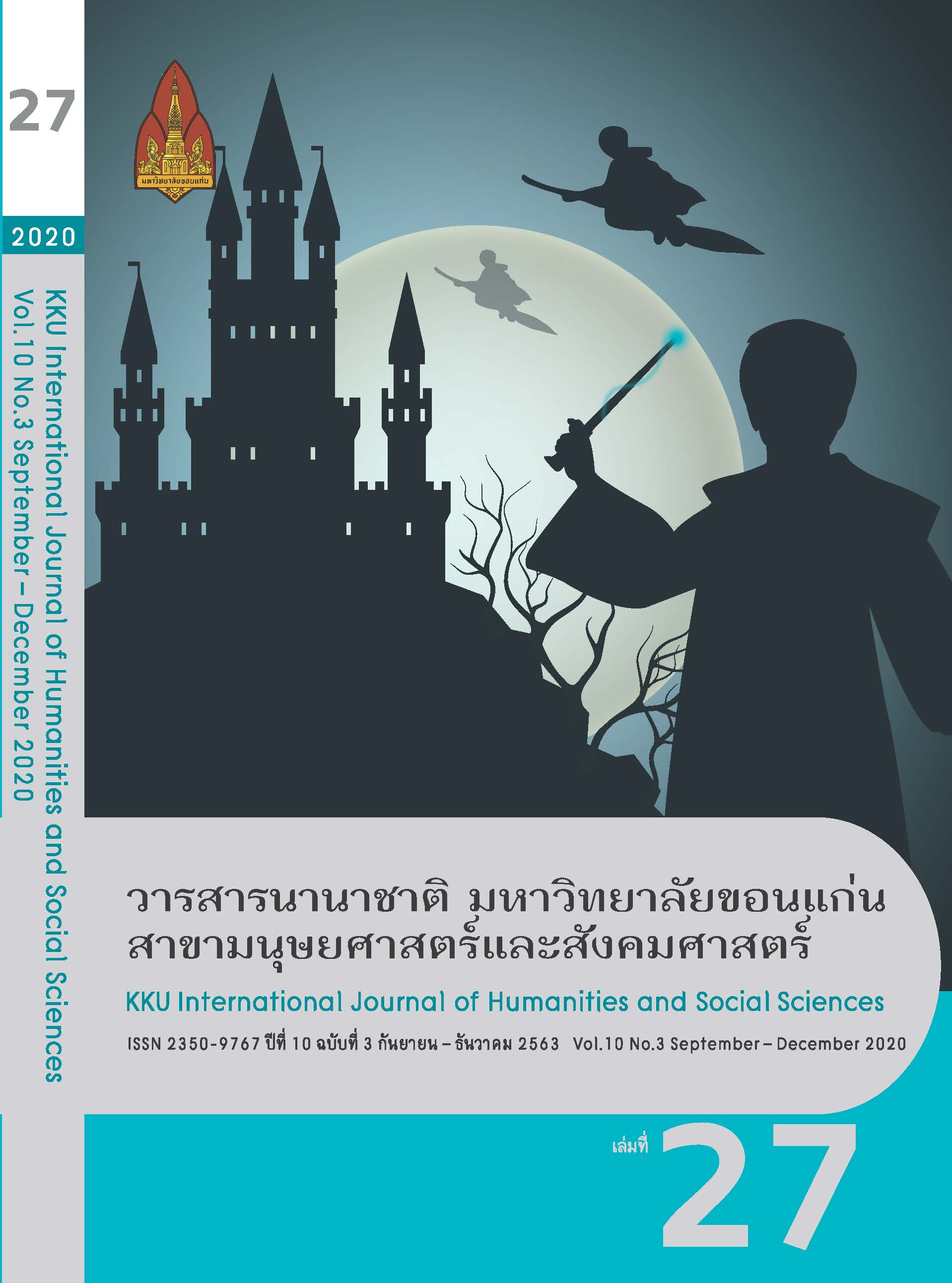English to Thai Translation Strategies on Unreal Nouns and Noun Phrases in “Harry Potter” Book Series
Main Article Content
Abstract
The objective of this research was to study English to Thai translation strategies on unreal nouns and noun phrases in “Harry Potter” book series. The research methodology was qualitative research. The research tools consisted of the English-Thai unreal noun and noun phrase record and the translation strategy record. Data consisted of English-Thai unreal nouns and noun phrases taken from the first three books of the “Harry Potter” book series. Data was analyzed by comparing the meaning of unreal nouns and noun phrases between English and Thai versions. Then those unreal nouns and noun phrases were analyzed to match with one of 18 translation strategies in the translation strategy record.
The research shows that 10 of 18 strategies were used in the translation. The strategies were used in two patterns: single strategy and mixed strategy. The 5 most frequently used translation strategies in the order of mean from high to low were as follows: 1) Translation by forming a new word in the target language by literally translating each lexical item of the source language 2) Translation by using loan blends (loan and target-language words) 3) Translation by using transliteration 4) Translation by forming a new word with lexical items of the target language and 5) Translation by forming a new word of the target language by literally translating each lexical item of the source language and using other related words.
Article Details
References
ชัยวัฒน์ คุประตกุล. (2554, มกราคม – มิถุนายน). มิติการแปลวรรณกรรมจินตนาการ. วารสารภาษาและวัฒนธรรม. 30 (1), 83 – 98.
วัลยา วิวัฒน์ศร. (2547). การแปลวรรณกรรม. (พิมพ์ครั้งที่ 2). กรุงเทพฯ: ภาควิชาภาษาตะวันตก จุฬาลงกรณ์มหาวิทยาลัย.
วลีพร หวังซื่อกุล. (2546). แฮร์รี่ พอตเตอร์ กับนักโทษแห่งอัซคาบัน. (พิมพ์ครั้งที่ 3). (แปลจาก Harry Potter And The Prisoner Of Azkaban. โดย J.K. ROWLING). กรุงเทพฯ: นานมีบุ๊ค.
สสส. (2557). วรรณกรรม 50 เรื่อง ที่ต้องอ่านก่อนโต. (พิมพ์ครั้งที่ 1). กรุงเทพฯ: บริษัทอมรินทร์พริ้นติ้งแอนด์พับลิชชิ่ง จำกัด (มหาชน)
สัญฉวี สายบัว. (2542). หลักการแปล. (พิมพ์ครั้งที่ 7). กรุงเทพมหานคร: สำนักพิมพ์มหาวิทยาลัยธรรมศาสตร์.
สุพรรณี ปิ่นมณี. (2546). การแปลขั้นสูง. (พิมพ์ครั้งที่ 1). กรุงเทพฯ: สำนักพิมพ์แห่งจุฬาลงกรณ์มหาวิทยาลัย.
สุมาลี. (2546). แฮร์รี่ พอตเตอร์กับศิลาอาถรรพ์. (พิมพ์ครั้งที่ 3). (แปลจาก Harry Potter And The Sorcerer ‘ s Stone. โดย J.K. ROWLING). กรุงเทพฯ: นานมีบุ๊ค.
สุมาลี. (2546). แฮร์รี่ พอตเตอร์ กับห้องแห่งความลับ. (พิมพ์ครั้งที่ 3). (แปลจาก Harry Potter And The Chamber Of Secrets.โดย J.K. ROWLING). กรุงเทพฯ: นานมีบุ๊ค.
อัจฉรา เทพแปง. (2555, กรกฎาคม – ธันวาคม). กลวิธีการแปลคำนามประสมจากภาษาอังกฤษเป็นภาษาไทยในนวนิยายเรื่อง “แฮร์รี่ พอตเตอร์กับศิลาอาถรรพ์”. วารสารสถาบันวัฒนธรรมและศิลปะ (สาขามนุษยศาสตร์และสังคมศาสตร์) มหาวิทยาลัยศรีนครินทรวิโรฒ. 14 (1), 95-104.
Baker, Mona. (2011). In Other Words: A Coursebook on Translation. (2nd ed.). Oxon: Routledge.
Kotarba Polly L. (2016). Harry Potter: A Link to the Fantasy Ganre. Retrieved August 1, 2016, from www.uh.edu/honors/...and.../pdfs/...novels/kotarba-03-kid-lit.pdf
Makinen, Katri. (2010). Harry Potter and The Challenges of Translation: Treatment of personal names in the Finnish and German transitions of the three first Harry Potter books by J.K. Rowling. Master’s Thesis, Department of Languages English University of Jyvaskyla.
Rowling, J.K. (1999). Harry Potter And The Chamber Of Secrets. (1st ed.). New York: SCHOLASTIC PRESS.
Rowling, J.K. (1999).Harry Potter And The Prisoner Of Azkaban. (1st ed.). New York: SCHOLASTIC PRESS.
Rowling, J.K. (1998). Harry Potter And The Sorcerer‘s Stone. (1ST ed.). New York: SCHOLASTIC PRESS.


